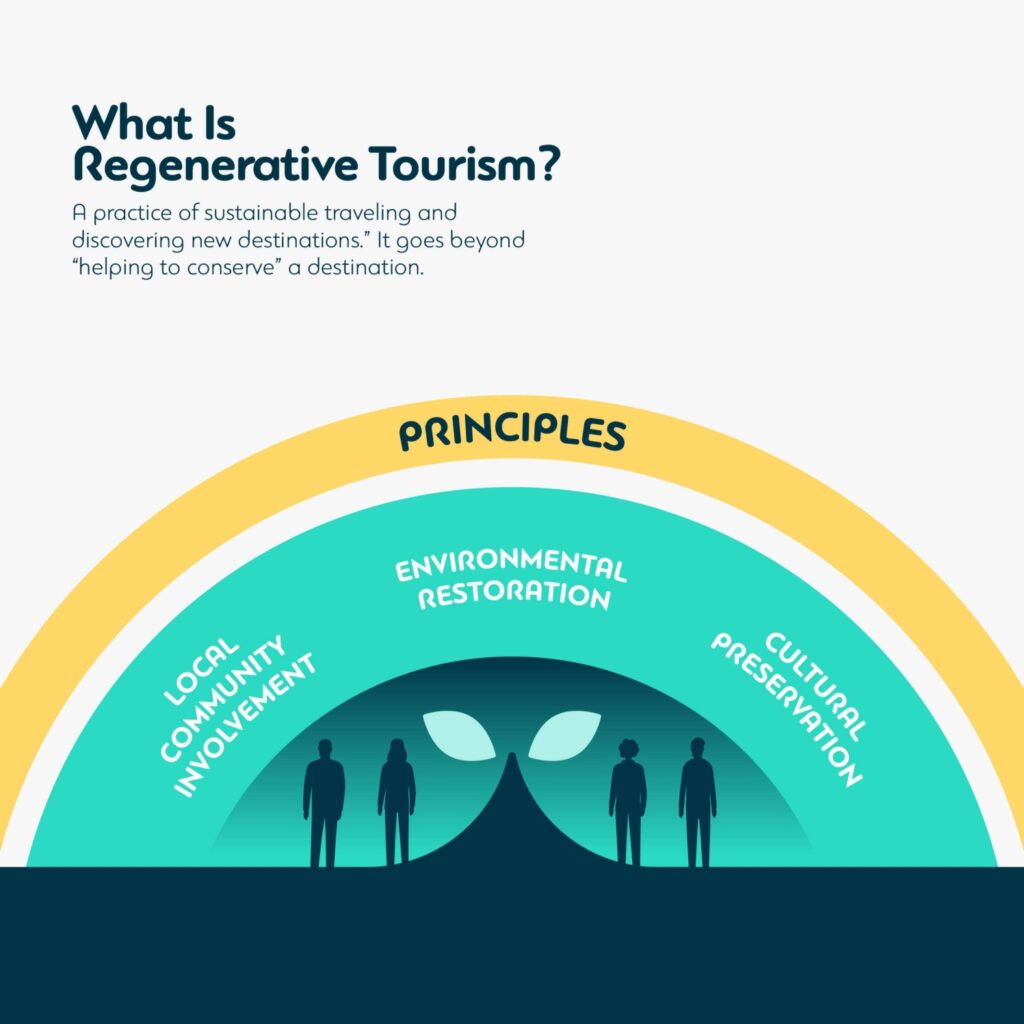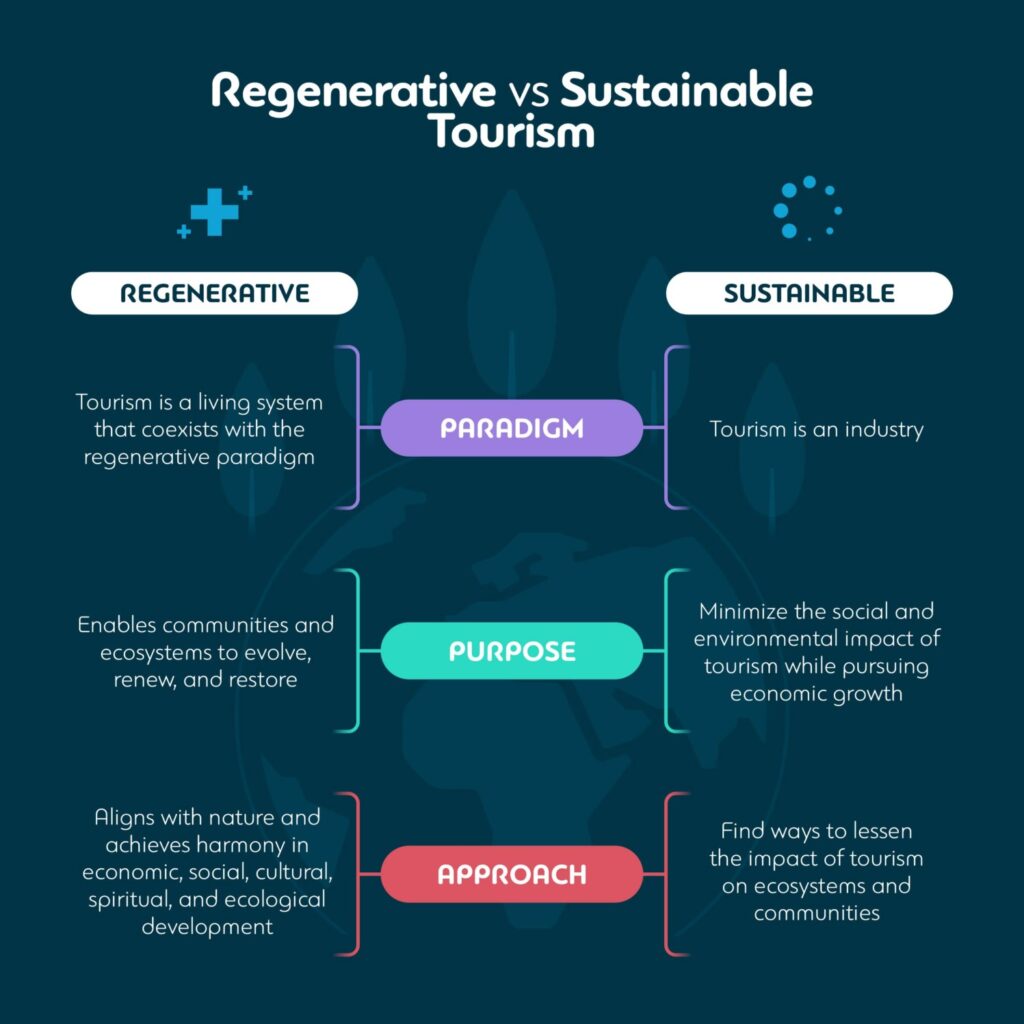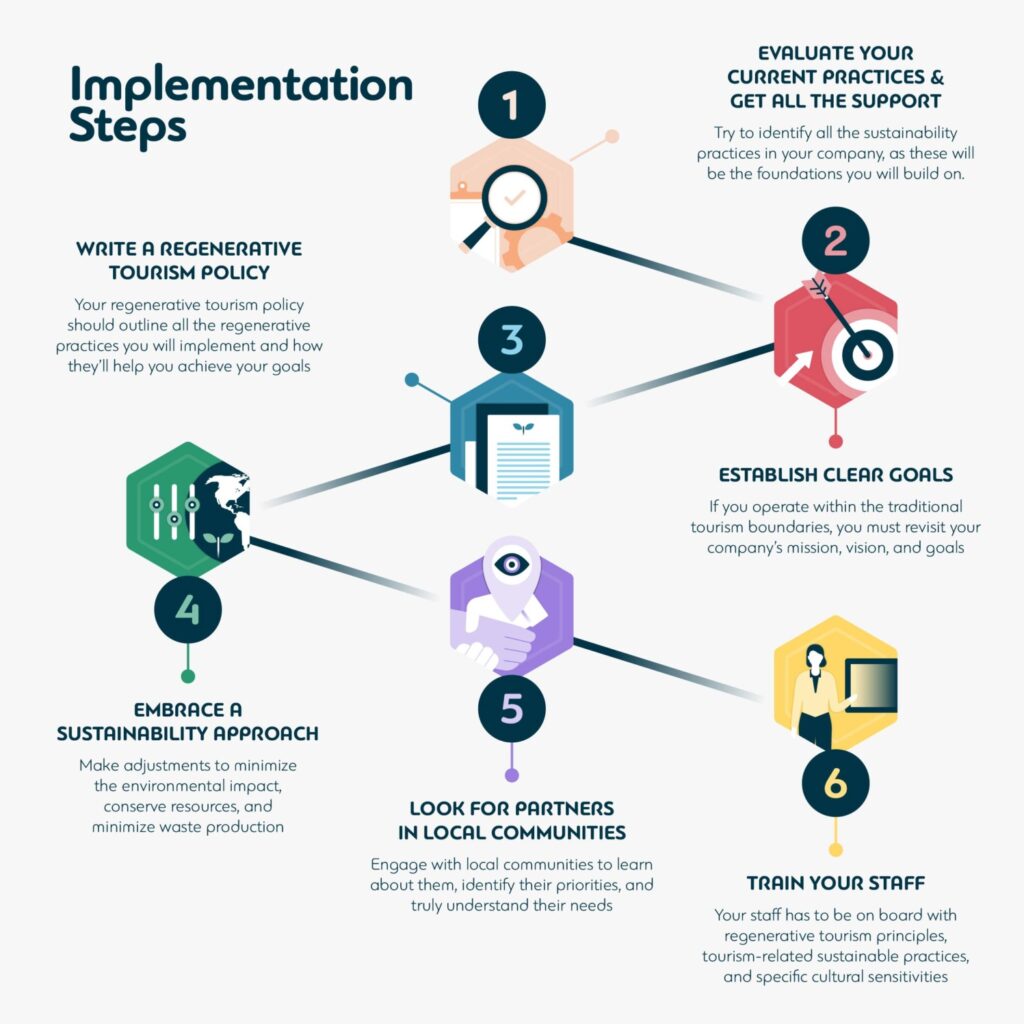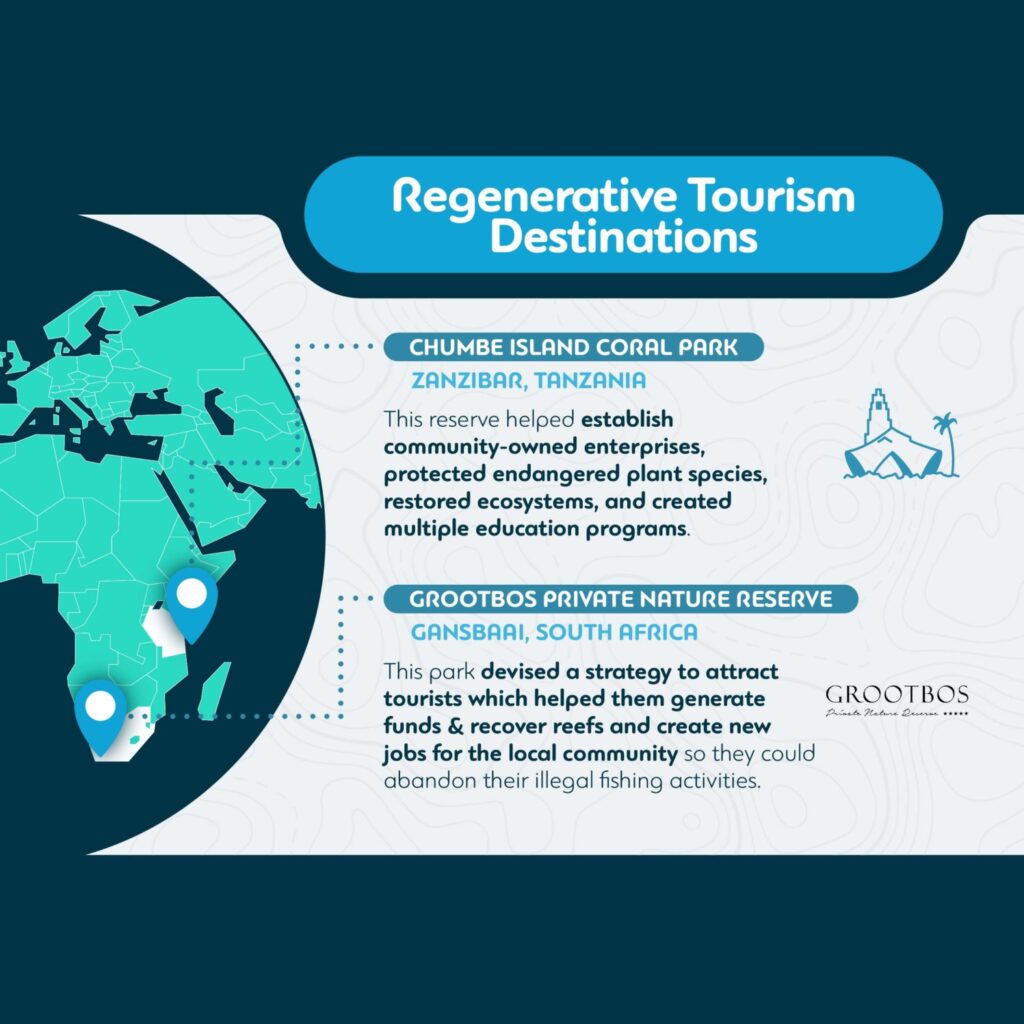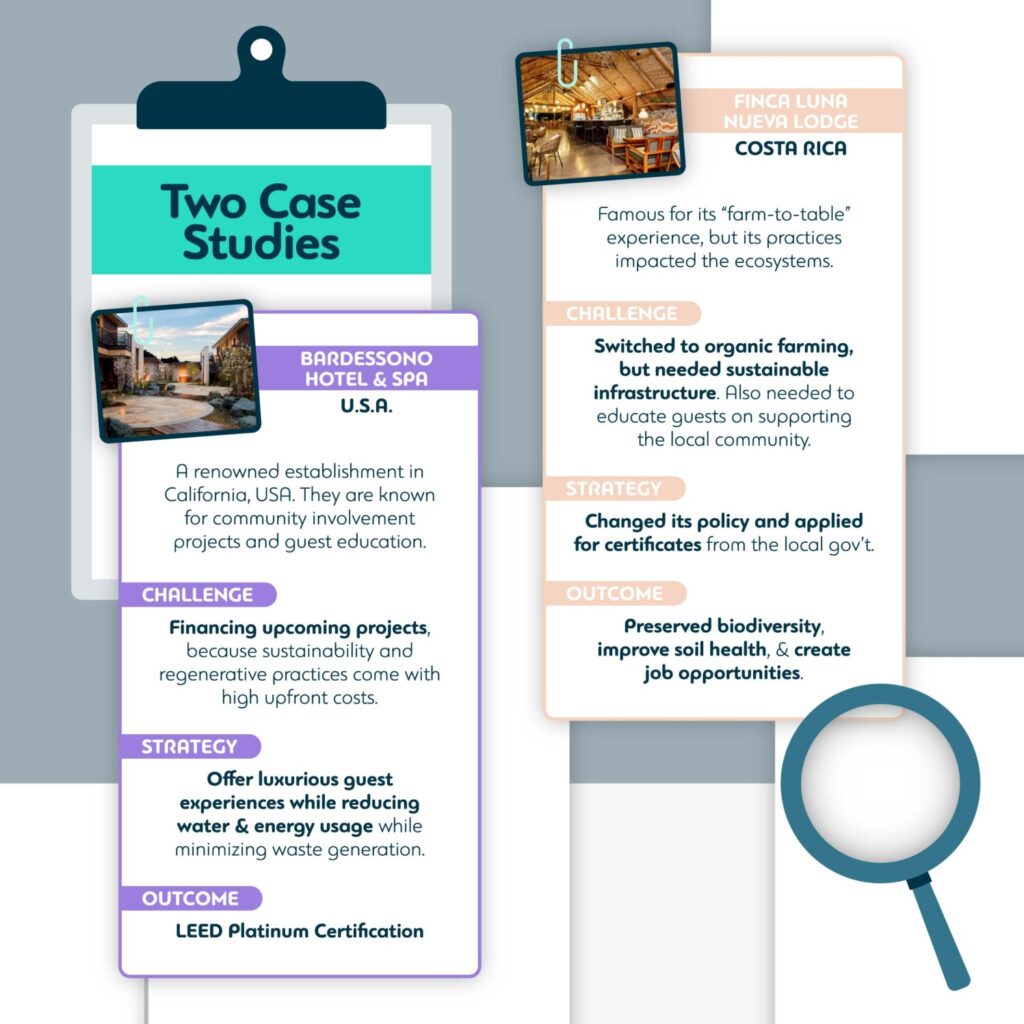Regenerative Tourism 101: What it is, Examples, Implementation, & More

- Understanding Regenerative Tourism
- Regenerative Tourism vs Sustainable Tourism
- The Implementation of Regenerative Tourism
- Regenerative Tourism Destinations
- 2 Case Studies: Regenerative Tourism Examples
- The Future of Regenerative Tourism
- Practical Guide to Adopting Regenerative Tourism
- Conclusion
- Frequently Asked Questions (FAQ)
Regenerative tourism is not a brand-new concept in the tourism industry. It’s a powerful force bound to transform traditional tourism and replace obsolete practices that mainly aims to replace exploitative and wasteful practices.
With this in mind, it’s easy to outline the importance of regenerative tourism in the current global context. It doesn’t only help preserve the destinations but also motivates the visitors to contribute to making destinations better, thus aligning the tourism industry’s goals with the goals of modern sustainable travelers.
However, regenerative tourism as a concept is rarely discussed in depth. Below you can find everything you need to know about it, including real-life examples. If you are operating a travel company and considering embracing regenerative tourism practices, this article may help you find the answer to the ultimate question:
“How can your business contribute to the regenerative tourism movement?”
Understanding Regenerative Tourism
Before you can successfully implement regenerative tourism best practices in your business, you need to understand the concept. A widely accepted definition goes along the following lines:
“Regenerative tourism is a practice of sustainable traveling and discovering new destinations.”
It goes beyond “helping to conserve” a destination. The main goal of this tourism is to inspire visitors to impact the destination positively. Positive impacts can include:
- Helping clean the environment;
- Assisting in building a better habitat for local wildlife;
- Contributing to revitalizing the environment.
Traditional tourism doesn’t include regenerative practices. Its paradigm is to explore the world and discover new and exciting destinations. Traditional tourism is a standalone sector, while regenerative one is deeply connected with many aspects such as economy, society, culture, and nature.
While regenerative tourism builds on traditional tourism’s foundation, it also adds new principles.
- Acknowledge that tourism processes take place inside an ecosystem – people are part of the ecosystem, and since the people are agents of tourism, they need to become guardians of the natural world;
- Recognize tourism as an industry responsible for creating conditions for both places and people to thrive – GDP growth is not the primary indicator of the success of tourism. It remains the indicator of success, but other factors such as well-being, cultural prosperity, landscape integrity, and community sentiment become important as well;
- The primary agent of tourism is the host community – regenerative tourism enables communities to become stewards of local ecosystems, thus allowing them to flourish and thrive together.
A great example of living up to these principles is Aotearoa in New Zealand.
A regenerative tourism example that includes people, places, and practices can be found in Aotearoa. The key to success is in understanding and implementing regenerative travel practices.
People in Aotearoa decided to make a Tiaki Promise which roughly translates into “acting as a guardian and protecting and preserving the home.” New Zealand businesses, including travel brands, recognized this idea which they now fully support.
It’s important to note that “Project Regenerative Tourism” is supported by the Sustainability and Resilience Institute of New Zealand. Its ultimate goal is to create long-term economic, social, environmental, and cultural well-being.
Regenerative Tourism vs Sustainable Tourism
Many people use regenerative and sustainable tourism terms interchangeably. However, these two are not the same. One of the recent studies identified nine key aspects in which these two concepts differ. Let’s tackle the most important ones:
- Paradigm:
- Sustainable tourism – tourism is an industry;
- Regenerative tourism – tourism is a living system that coexists with the regenerative paradigm.
- Purpose:
- Sustainable tourism – minimize the social and environmental impact of tourism while pursuing economic growth;
- Regenerative tourism – enables communities and ecosystems to evolve, renew, and restore.
- Approach:
- Sustainable tourism – find ways to lessen the impact of tourism on ecosystems and communities;
- Regenerative tourism – aligns with nature and achieves harmony in economic, social, cultural, spiritual, and ecological development.
The limitation of sustainable tourism is that it only focuses on lessening the impact of tourism on ecosystems and communities. It doesn’t have the momentum to motivate people to conserve and restore plants and wildlife while creating more opportunities for communities. Simply put, these two concepts are closely related. In fact, regenerative tourism starts with sustainability, as it’s the requirement for the regenerative process to start.
There are many potential benefits of adopting a regenerative approach over a merely sustainable one. The most noteworthy ones include:
- Increased resilience of ecosystems;
- Tourists can enjoy destinations for many years to come;
- Improve bottom line for travel companies;
- More predictable developments in the natural and business worlds;
- Increased local support for tourism;
- Improved quality of life of local communities;
- Preserved cultural heritage.
The Implementation of Regenerative Tourism
If you want to tap into the regenerative travel market as a tourism company, you can face many challenges. That’s simply because you don’t have experience with it. Lack of experience is not the only challenge; you may also not know how to devise a strategy. Here are the steps you need to take to implement regenerative tourism in your processes.
Step 1: Evaluate your current practices and get all the support
Try to identify all the sustainability practices in your company, as these will be the foundations you will build on. If you are a medium or large business, you will need to get all the stakeholders and top management on board with your idea as well.
Step 2: Establish clear goals
If you operate within the traditional tourism boundaries, you must revisit your company’s mission, vision, and goals. Let your company values and objectives guide you on this journey.
Check if there is already something in your statements that you share with the principles of regenerative principles. If you need help establishing clear goals, you can always brush up on your knowledge of the SMART goal-setting strategy.
Step 3: Write a regenerative tourism policy
To truly commit to regenerative practices, you must write a new company policy. Your regenerative tourism policy should outline all the regenerative practices you will implement and how they’ll help you achieve your goals.
Step 4: Embrace a sustainability approach
Now you have to make some concrete adjustments. For instance, you can revisit your processes and identify operations where you can make adjustments to minimize the environmental impact, conserve resources, and minimize waste production.
Step 5: Look for partners in local communities
Local communities make a vital part of the entire regenerative tourism landscape. To truly implement this type of tourism, you need to support them and look for potential partnerships.
You should engage with local communities to learn about them, identify their priorities, and truly understand their needs. You can also partner with local small businesses and venue managers to help create more opportunities for local residents.
Step 6: Train your staff
Your staff has to be on board with regenerative tourism principles, tourism-related sustainable practices, and specific cultural sensitivities. It will help them contribute to your brand’s regenerative tourism efforts.
The role of local communities, governments, and tourism businesses in this process
Local communities, governments, and tourism businesses have a massive role in the implementation of regenerative tourism. Let’s quickly go through their most impactful roles:
Local communities
Local communities are vital for the long-term success of regenerative tourism initiatives. The more they are empowered, involved, and engaged, the better, as it promises better outcomes when implementing the initiatives.
Furthermore, all the knowledge about the particularities of the destination, cultural heritage, and tradition is with the local community. It can help make the destination more attractive and engaging for tourists. Plus, the communities are already interested in this concept.
In fact, a survey discovered that 96.3% of local residents in one destination responded with a resounding yes to regenerative travel.
Governments
The governments are important for the success of this process as well. They are the ones responsible for frameworks, regulations, and policies that can promote regenerative tourism and facilitate its implementation.
They can also leverage their offices to ensure compliance and maintain quality control. Additionally, governments can allocate budgets to fund relevant projects such as conservation and regeneration efforts and nature-friendly infrastructure development.
Tourism businesses
Tourism businesses can promote regenerative tourism and facilitate its implementation by setting up a network. The network can enable collaboration which can prove vital for adopting regenerative and sustainable practices at scale. For instance, they can use their marketing platforms to promote regenerative tourism products and services together.
However, remember that this goes beyond the tourism business, as regenerative tourism is a holistic approach and can benefit from companies from other industries as well. The following case study showcases this exception exactly.
Earthship Biotecture is an architecture company like none other. They specialize in off-grid living and sustainable architecture. The company only uses recycled materials and comes up with designs to facilitate rainwater harvesting, renewable energy, and minimal impact on the environment.
Due to its unconventional design and building methods, the company had problems obtaining the permits required to bring its projects to life. It also had to overcome logistical challenges because the company often had to build in remote locations. They overcome it by:
- Educating authorities and building code officials about the materials they use and their building methods;
- Collaborating with local communities to involve them in the building process and overcome logistical challenges. The company trained local residents in unique building techniques and utilized local materials to achieve the best results;
- Staying flexible when it comes to their building designs – they adopted their designs to comply with the most strict regulations.
The challenges and potential solutions in implementing regenerative tourism
Regenerative tourism is among the newest concepts in the tourism sector. Understandably, there are several challenges to expect when trying to implement it. Here are the most common ones and the potential solutions to overcome them.
- Limited understanding of regenerative tourism – all parties, including travelers, travel brands, governments, and local communities, don’t completely understand regenerative tourism principles. You can overcome this challenge by organizing education and round tables. You should focus on the benefits this concept brings and enable training for parties which can help in the further promotion of regenerative tourism;
- Lack of funds – this is yet another field that requires upfront investments. Where to look for money? You can apply for grants and other incentives with NGOs, governments, and financial institutions that are willing to invest in regenerative practices;
- Lack of collaboration – collaboration can slow down the implementation process; You can facilitate collaboration by entering and promoting partnerships. Multi-stakeholder platforms and public-private partnerships are potentially quite powerful in this scenario.
Regenerative Tourism Destinations
The best way to understand regenerative tourism is to closely examine destinations that are leaders in this field. Grootbos Private Nature Reserve in South Africa and Chumbe Island Coral Park in Zanzibar are perfect examples.
Grootbos Private Nature Reserve in South Africa embraced regenerative tourism. They did it through education, community empowerment, and conservation. As a result, they had more nature-based experiences to offer to travelers.
However, the reserve faced many challenges, including socioeconomic inequalities, endangered plant species, and continuous land degradation. They tackled the challenges from two sides. They helped establish community-owned enterprises, protected endangered plant species, restored ecosystems, and created multiple education programs.
Chumbe Island Coral Park in Zanzibar is a famous destination for its coral reef ecosystem. The park had to deal with multiple challenges at the same time. They had problems with finances, coral reef ecosystem decline, and illegal fishing.
The park devised a comprehensive strategy to attract tourists interested in sustainable and regenerative tourism activities. It helped them generate funds and recover reefs and create new jobs for the local community so they could abandon their illegal fishing activities.
2 Case Studies: Regenerative Tourism Examples
Let’s dive deeper into other relevant case studies. Below you can find two regenerative tourism examples, including the used strategies, the challenges they faced, and the outcomes achieved.
Bardessono Hotel & Spa, United States
Bardessono Hotel & Spa is a renowned establishment in California, US. We are talking about the state pioneering sustainability and regenerative ideas across the fields. They are known for community involvement projects and guest education. In their efforts to implement regenerative tourism, they faced several challenges.
The primary challenge was financing the upcoming projects. It’s simply because sustainability and regenerative practices come with high upfront costs. Plus, we are talking about an already-established luxury hotel that attracts guests with high expectations.
This hotel decided to innovate and embrace new solutions – the trick was to continue to offer luxurious guest experiences while reducing water and energy usage while minimizing waste generation. The outcome of their efforts was the LEED Platinum certification that the hotel received.
Finca Luna Nueva Lodge, Costa Rica
Finca Luna Nueva Lodge in Costa Rica is famous for its “farm-to-table” experience. However, its practices impacted the ecosystems, and the establishment embraced a more sustainable and regenerative approach.
In an effort to regenerate the ecosystem, the lodge decided to switch to organic farming. To do that, they needed sustainable infrastructure. By then, the hotel had guests who didn’t deeply care about the local ecosystem and community. They also needed to educate guests on why supporting the local community and participating in regenerative practices is essential.
The lodge changed its policy and applied for certificates from the local government. They also invested in sustainable infrastructure. They are often used as an example of regenerative tourism success in Costa Rica because they managed to preserve biodiversity, improve soil health, and create job opportunities for the local community.
Lessons learned and insights for other tourism businesses
While each travel company operates in its own context, if you decide to implement regenerative tourism, you will face one of the most common challenges. Learning from other travel brands can make your operation more agile and enable you to adopt a proactive approach.
Here are the most valuable lessons and insights to help you navigate the complex landscape of regenerative tourism waters:
- A holistic approach is a winner – you need to consider the economic, environmental, and social aspects of regenerative tourism. Striking the right balance among these three is a recipe for success;
- Collaboration is key to success – you will deal with many more stakeholders here than in traditional tourism. Make sure to maintain open lines of communication with suppliers, employees, trailers, local communities, and governments to enable collaboration;
- Local context is your guideline – you should tailor your regenerative tourism products and services with local context in mind. Everything you do has to be greenlighted by all stakeholders;
- It’s a long-term commitment – never fall into the trap of thinking this is a one-time project. Regenerative tourism is an ongoing project and should be acknowledged as such. It will help you embed its principles into your business’s core values and set the course for success.
The Future of Regenerative Tourism
If you are wondering if there are any potential impacts of regenerative tourism on the global tourism industry, there are many. First of all, this type of tourism aims to not only preserve delicate ecosystems but also regenerate them. It can ensure the longevity of the tourism industry and safeguard the resources that attract tourists.
The entire tourism industry can become a force for positive change thanks to regenerative tourism. Don’t forget its inclusive approach, which involves many stakeholders, creates new job opportunities, and promotes authentic cultural experiences.
It can help popular tourism destinations successfully thwart the risks of over-tourism. It all happens through the promotion of alternative destinations and diversifying offers.
If you want to learn more about the future of this tourism type, you need to be familiar with the trends in this niche. Here are the most noteworthy ones.
Let’s start with the “cut down on food waste” trend. Many destinations will begin to grow organic food and source it from local farmers. Benjamin Lephilibert’s take on this trend is the following:
“For example, grow food onsite, source food locally, and shift social norms to ensure that “plate waste” is no longer considered acceptable.”
One of the main trends in the travel sector is the increasing demand for immersive nature-based experiences. Travelers are becoming more interested in eco-lodges, conservation volunteering, and wildlife encounters. A travel industry expert and editor of the “Make me sustainable” blog shares her prediction about this trend:
“Ecotourism and nature-based tourism will continue to gain momentum as travelers prioritize authentic experiences and environmental conservation.”
Technology and innovation are driving solutions across sectors. In regenerative tourism, they are driving sustainable and regenerative solutions. Mainly, they enable renewable energy, data-driven decision-making, and smart infrastructure. One of the authors of a recently published research paper states the following:
“Technological advancements will play a significant role in enabling regenerative tourism, allowing for more efficient resource management, enhanced guest experiences, and informed decision-making for sustainable development.”
The list of technologies contributing to the implementation of regenerative tourism is comprehensive. Nevertheless, let’s name a few:
- Smart grids and energy management systems;
- Internet of Things and Sensors;
- Waste Management Technologies (waste-to-energy systems, anaerobic digestion, advanced recycling systems);
- Virtual Reality and Augmented Reality;
- Blockchain (fair trade practices, authentication of eco-certifications, and tracking the origin of locally sourced products).
Let’s end with quoting Anna Pollock, a thought leader in the travel sector and change catalyst in regenerative tourism:
“Regenerative tourism is all about reinventing the sector, making it so much more inclusive than it is now.”
Practical Guide to Adopting Regenerative Tourism
Since we’ve already covered the step-by-step guide for businesses looking to implement regenerative tourism, let’s tackle the common pitfalls to avoid and look at some resources for further learning.
The most common pitfall of them all is greenwashing. There is no need to mislead stakeholders and travelers to think your practices are more sustainable than they actually are. It can erode trust and cause more damage down the line. Furthermore, your regenerative tourism initiatives won’t be credible if you are not transparent.
Your implementation efforts can also fail if you don’t establish clear goals and vision. Make sure to align your company’s vision and goals with regenerative tourism principles to easily avoid this trap.
Finally, your strategy can fail if you don’t plan in detail, especially regarding resource allocation. Make sure to devise a detailed implementation strategy and plan. Your plan should clearly outline responsibilities, timelines, and resource allocation.
Since the implementation process can quickly derail because there are many factors, make sure to regularly review and adjust your strategy.
Finally, you want to also engage tourists in regenerative practices. To be successful at it, you should consider the following tips:
- Enable tourists to learn about regenerative tourism (brochures, exhibits, guided tours, workshops);
- Work on your messaging (communicate the value and impact of their actions);
- Enable tourists to actively engage in regenerative activities;
- Offer incentives and rewards to tourists who excel at these activities.
Conclusion
Hopefully, you now understand the regenerative tourism concept and how it differs from traditional and sustainable tourism. This is a brand-new initiative in the tourism industry. However, since it uses sustainable tourism as the foundation and there is demand for it in the market, this sector has a bright future ahead of it.
Overtourism, decaying ecosystems, and uncertainty in economies worldwide have, to some extent, created the urgency of the shift to regenerative tourism. It’s clear that this type of tourism has a lot to offer to all stakeholders, including the ecosystems and local communities at destinations.
Ultimately, the question is not whether you will implement it but when.
“What steps will you take towards regenerative tourism?”
Frequently Asked Questions (FAQ)
You should start by evaluating your current practices. Establish clear business goals aligning with regenerative tourism principles and write a regenerative tourism policy.
Thanks to regenerative tourism, you can access funding and grants, gain a competitive advantage, generate repeat business, increase customer loyalty, expand your market reach, and boost brand value.
You can enable tourists to learn more about regenerative tourism practices, custom-tailor your messaging, and offer rewards and incentives to tourists who engage in regenerative initiatives.
Some successful examples of regenerative tourism initiatives include Finca Luna Nueva Lodge, Grootbos Private Nature Reserve, Bardessono Hotel & Spa, Chumbe Island Coral Park, and Earthship Biotecture.
Technology fosters sustainable practices and positive impacts, especially solutions for sustainable management systems, data collection and analysis, VR, AR, online booking, mobile apps, blockchain, and digital collaboration.
Subscribe to
our newsletter
Yay! You are now
subscribed to our
newsletter
Mize is the leading hotel booking optimization solution in the world. With over 170 partners using our fintech products, Mize creates new extra profit for the hotel booking industry using its fully automated proprietary technology and has generated hundreds of millions of dollars in revenue across its suite of products for its partners. Mize was founded in 2016 with its headquarters in Tel Aviv and offices worldwide.
Related Posts

Unveiling the 13 Hottest Travel Trends of 2024
13 min. No one knows better than you how dynamic the realm of travel is. Dynamic shifts brought by technological strides, ever-changing traveler priorities, and global events are the new normal in 2024. How do you navigate this landscape that keeps transforming? You should familiarize yourself with the very travel trends that shape the world […]

30 Most Important Travel Industry Events for 2024
30 min. Many travel industry experts believe that travel industry events play a pivotal role in shaping the future of the travel industry. Why is this so? It’s because these events foster collaboration, networking, and innovation among key stakeholders in this vertical. As a platform for sharing best practices, trends, and insights, travel industry events […]

Empowering Equality: Mize Leads the Way in Travel Technology
7 min. Are we all equal? Are we all equally represented in the business world? In some professional sectors, there might still be some under-representation of women, minorities, and the LGBTQIA+ community. The tech sphere is no different, but is the travel tech sector a spark of hope? As the business world becomes more diverse, […]
